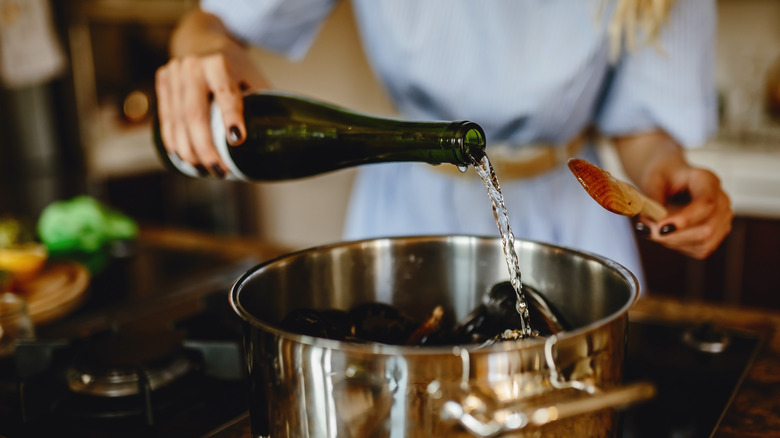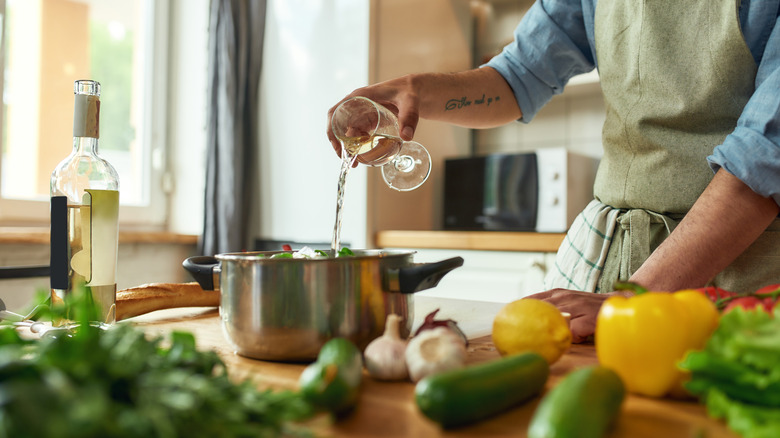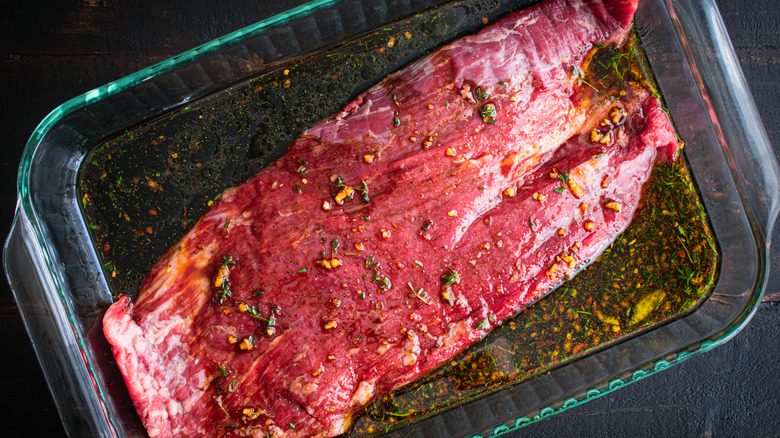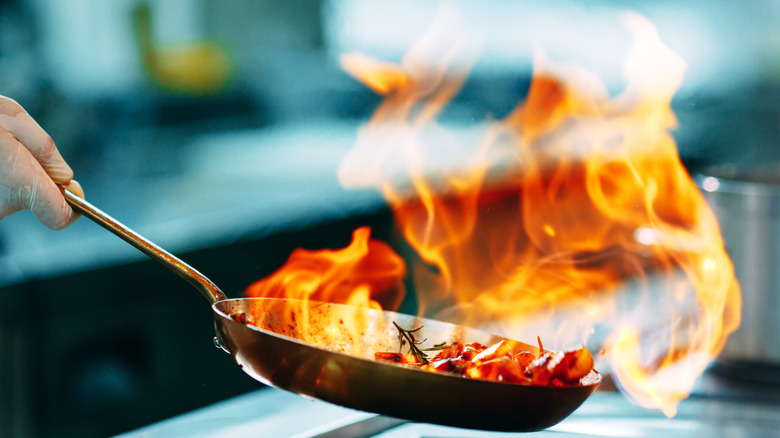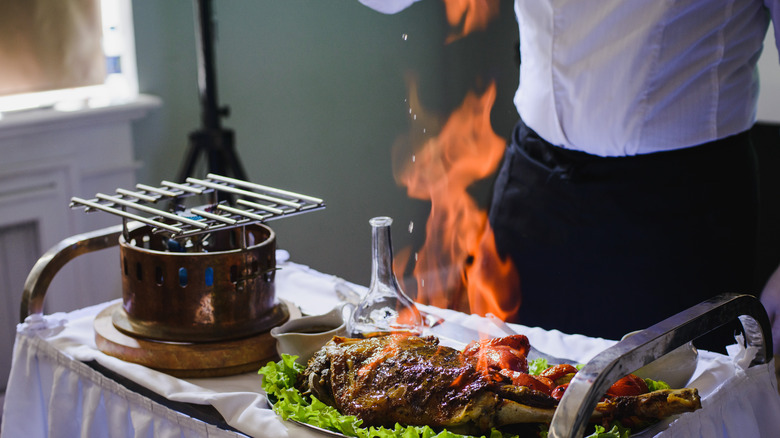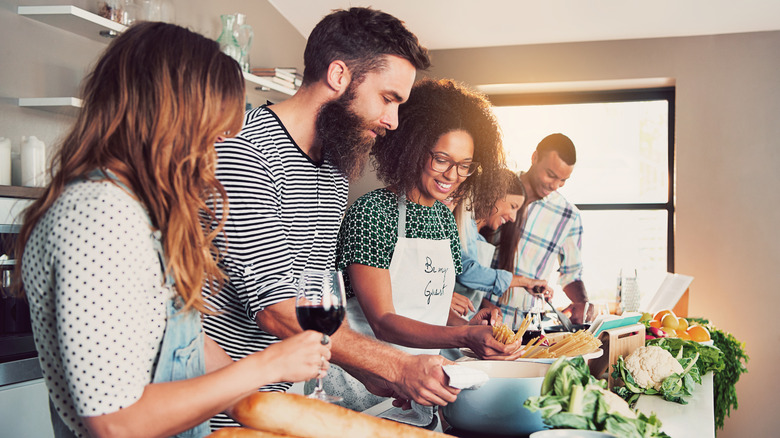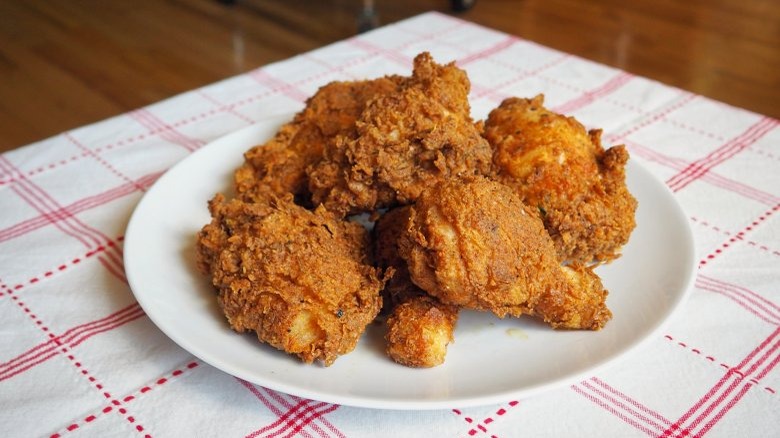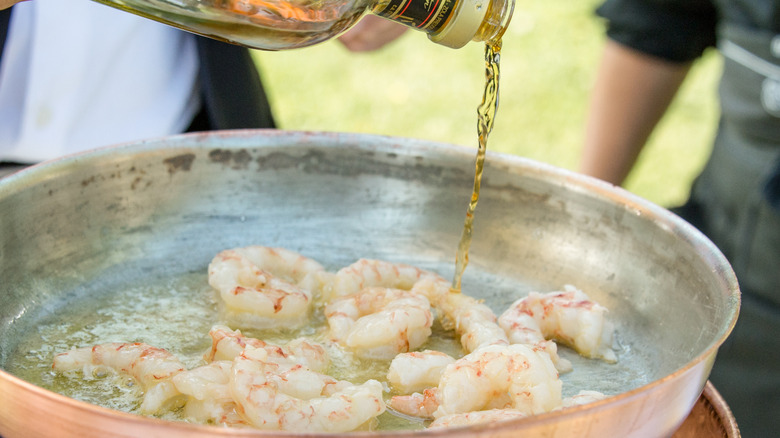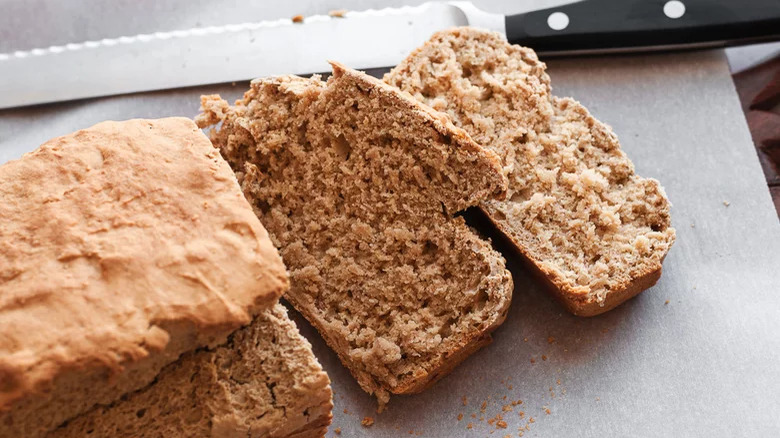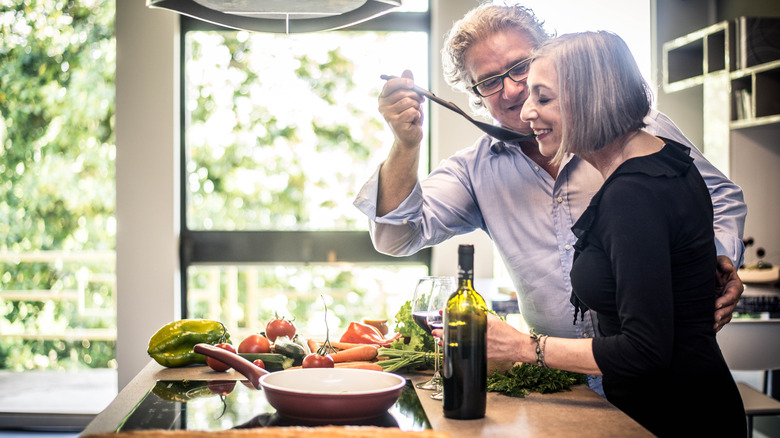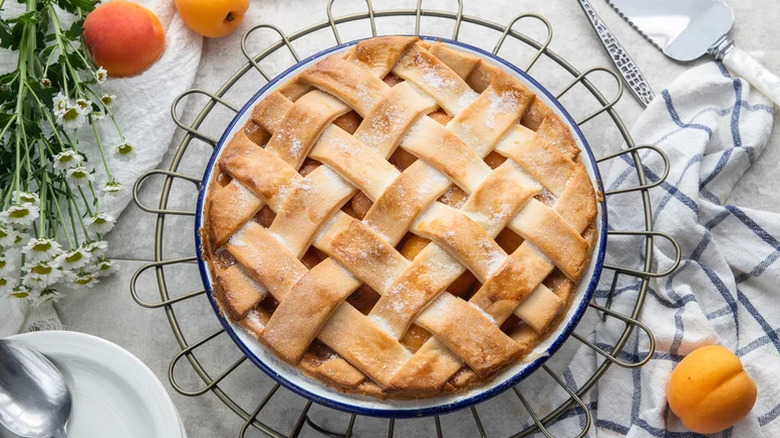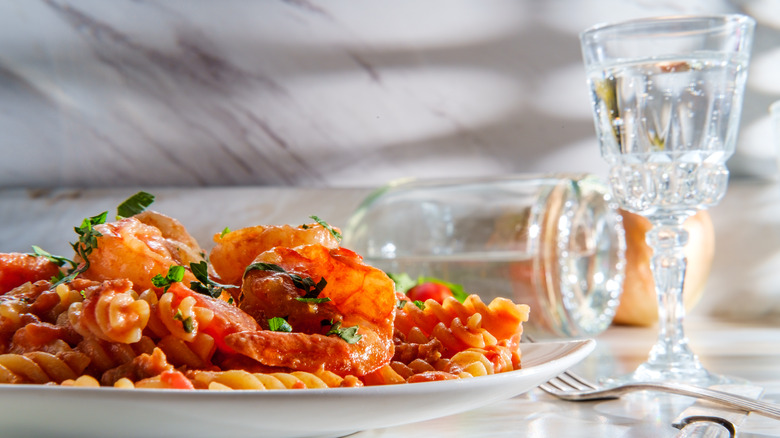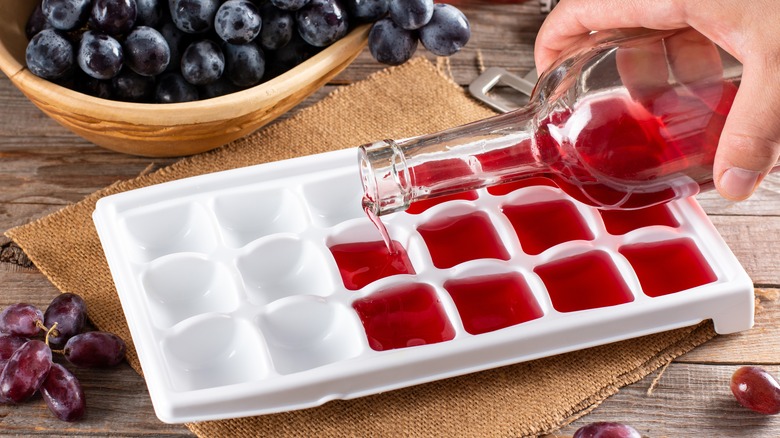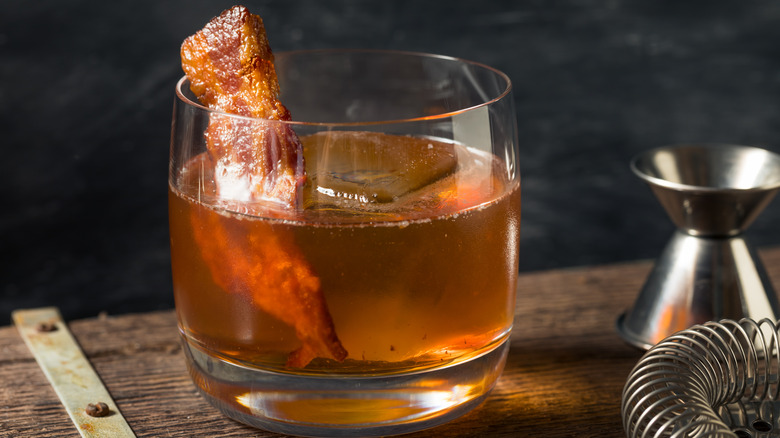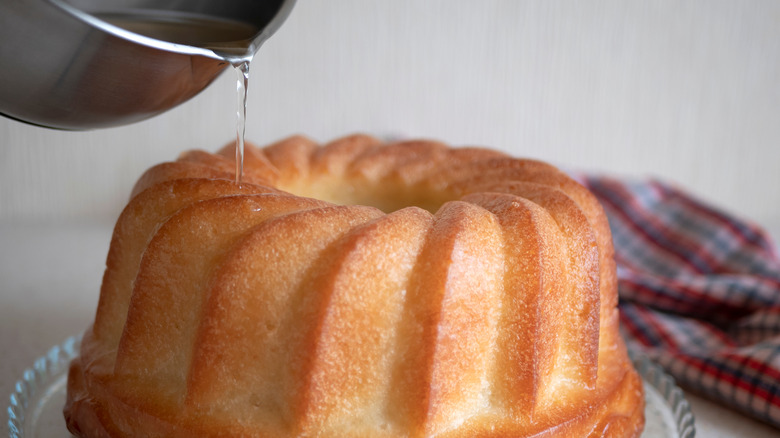14 Tips On How To Cook With Alcohol
TV chef Julia Child famously said, "I enjoy cooking with wine, sometimes I even put it in the food" (via Town & Country). You can also cook with vodka, beer, and even tequila. You can add alcohol to a marinade, create a pasta sauce with it, and make savory or sweet dishes with it. You can even make bread with it, fried chicken, and ... wait for it ... pastry.
Alcohol intensifies flavors and elevates ingredients while adding a distinct taste and even texture to a dish. Irish-headquartered international food group Kerry notes that there's an upward trend for using alcohol in recipes. The food producer suggests some delicious combinations such as cider and chicken wings, shrimp tacos made with tequila and lime, and short ribs braised in ale. One liquor that's becoming increasingly popular is bourbon (so you might want to try our sweet and tangy bourbon chicken). It's time to fling open your drinks cabinet and welcome the aromas of alcohol into your kitchen. Here are some tips to take along the way.
1. Be aware that alcohol does not burn off
When you add alcohol to a simmering pan you might think that you're adding an essence of whiskey or a hint of wine, rather than a hefty shot or large glass of red. However, you're not actually burning off that much alcohol. An Alcohol Professor feature references "On Food and Cooking: The Science and Lore of the Kitchen" by Harold McGee on this point. Various factors influence this such as cooking time and temperature. The other ingredients you use also play a role, as does the way the dish is cooked and the surface area of your pan.
The boiling point of alcohol is 173 degrees Fahrenheit. At this level, cooking for 15 minutes gets rid of around 60% of the alcohol content, according to the USDA. The alcohol remaining drops from 40% to 35% after 30 minutes, then 25% after an hour, and 10% after a couple of hours. A stew that's in the oven for 2 hours and 30 minutes will still retain 5% alcohol. Alcohol-based sauces just brought to the boil may retain 85% alcohol (via Idaho State University).
2. Marinate meat in alcohol to make it tender
There's nothing as succulent as melt-in-your-mouth marinated meat cooked to perfection. You don't need a complex marinade, either. Our steak marinade is made with only three ingredients: soy sauce, olive oil, and balsamic vinegar. The key components to tenderize the meat and add taste are acid, such as alcohol or lemon juice, plus fat and flavorings. Just don't leave meat sitting in an acidic mix too long because it'll end up rubbery.
Maximum marinating time is 4 hours, and it takes a minimum of 30 minutes for the marinade to work its magic. Leave chicken for no more than 90 minutes, and a couple of hours tops for tender cuts of meat. The tougher the meat, the longer you can leave it. Fine Dining Lovers suggests using a mallet to tenderize meat before adding a marinade. Meanwhile, because the alcohol adds flavor, you can match this with your meat and the overall taste you want to highlight: Whiskey brings out cookout-style smokiness, while rum can bring out the sweetness of pork.
3. Flambé the safe way
Nothing shows you mean chef-style business in the kitchen more than flames leaping from a pan as you flambé. You could serve our bananas Foster recipe ablaze. Bravo! However, before you get carried away with some kitchen theatrics, make sure you're adding safety into the mix too. Nothing ruins a dinner party quite like a flambé that's out of control or food that's scorched beyond all recognition.
On Jamie Oliver's YouTube channel, French Guy Cooking demonstrates how to set your culinary passions alight without setting anything else on fire. Choose an all-metal pan and one that doesn't have a short handle. Don't flambé under a kitchen hood, and stay back from the area above the pan. Another must-follow safety tip is to only add a little alcohol and pour this from a glass, not straight from the bottle. When lighting the alcohol, best to use a stick lighter or long matches. Keep your pan lit until the flames go out or put a pan lid over the top to extinguish it sooner. Bon appétit!
4. Heat alcohol to flambé at the table
If you love the depth of flavor that a flambé creates or simply love a touch of culinary theatrics, then Wonder How To offers a simple tip for flambéing at the table. It's not just about looking good, either. The whole point of flambé is to add a rich boozy edge to a dish while burning off the excess liquid from your alcoholic pour. This way your dish will avoid becoming soggy. If you want some extra liquid in your dish, then extinguish the flames a little earlier to preserve them.
According to What's Cooking America, you should select alcohol that's around 80-proof. Heat your booze of choice on the stove before flambéing; keep a large metal lid on hand for safety; and consider using a serving cart slightly away from your table to impress your guests without putting anyone's safety at risk. It might be a good idea to do a dry run of your performance to avoid any flambé mishaps during opening night. That way you're sure to get a round of applause.
5. Use wine reductions for pasta sauces
Cooking pasta dishes with crisp Italian wine is perfect. The flavors of the wine permeate the sauce and elevate the whole meal. The air fills with appetite-inducing aromas as wine bubbles away on the stove with the promise of a home-cooked pasta dish. Then there's the distinct taste of the wine shining through as you bite into velvety pasta in a classic sauce. The key step in using wine in pasta sauces is the reduction (via Livestrong).
Wine isn't added to pasta sauces at the end, and this can ruin the overall balance and taste. Add once you've fried your mirepoix or other base ingredients. Deglaze the pan so that all the fried, flavorful bits are absorbed into the final sauce. Let the wine simmer away until it's reduced to ensure that the flavor of the wine doesn't overpower the sauce. With less liquid, there's less alcohol content. Once you've reduced your wine, add any other liquids to make up your sauce such as stock, clam juice, or cream. You can also use red wine to make pasta dishes such as our Bolognese.
6. Create crispy chicken with vodka batter
The ingredients that go into the coating of KFC may be a safely-guarded secret. However, if you want to recreate that iconic crispy chicken taste then you might want to try our copycat KFC chicken recipe. The buttermilk marinade keeps the meat tender, while a touch of MSG with plenty of dried herbs creates that crisp umami flavor. Fried chicken may not be haute cuisine, but there are plenty of different techniques that add unique flavors. One ingredient that's not common in many deep-fried chicken recipes that can make it crispier than ever is revealed by The Daily Meal. And you'll never guess what it is. Okay, the clue is in the title, it's vodka.
Try marinating the chicken in brine with a shot of vodka before coating and frying. The rapid evaporation of the alcohol results in a crunchier surface and a tastier piece of chicken. The alcohol burns off so quickly that there's no risk of steam softening the crisp as could be the case with another liquid such as water. If you add the liquor to the batter, it interacts with the gluten in the flour in a way that keeps the batter from becoming stodgy. Because the batter is lighter as a result of using alcohol in place of water, it reacts better with the hot oil to produce a thinner, crispier coating (via Modernist Cuisine).
7. Keep the flavors balanced
Whether you're cooking with wine, beer, or liquor it's important that the flavors balance with other ingredients. You may love the nuttiness of bourbon pecan praline, but what could ruin these sweet treats is too much of a boozy kick or not quite enough. One of the worst mistakes you can make when cooking with alcohol is letting the flavor of the alcohol take over. The notes of whatever alcoholic ingredient you've added should be nuanced. A recipe should point you in the right direction with how much alcohol to add and when.
The key to finding balance is knowing what alcohol complements certain proteins. There are no hard and fast rules, but generally speaking, the darker the meat, the darker the alcohol that pairs well with it. It's the same concept the other way around. So if you're making a dish with shrimp, for example, then a liquor that's light in color works best. And a stout would work well with beef (via Kerry). Livestrong also points out that the flavors are defined by how you cook the alcohol. With a pasta sauce, for example, you want the wine to infuse so that the flavors come together before adding any pre-cooked or quick-cooking meat. The taste and texture will suffer if you cook your protein in alcohol. As well as creating an overpowering taste, it may make your meat dry up, affecting the balance of flavors.
8. Bake bread with beer
It's the aroma that you get when it's rising in the oven. It's the mindful pleasure you get from kneading soft dough in a way that's been around for centuries. Baking bread is so wonderfully satisfying, whether you're making a sourdough or classic white loaf. What really makes this carb so extraordinary is how the flour and yeast and whatever else you add into the mix come together in perfect harmony. Did you know that you can bake bread with beer too? If this sounds like a perfect match, then read on.
Beer bread has a long tradition in Germany and while beer may be yeasty in flavor, it's not a substitute for yeast in bread-making. You use the beer in place of water or any other liquid (via World-Grain). There's yeast-free bread too, such as an Irish beer bread presented by Tasting Table. For this, you'll need to mix 3 cups of flour with 4 teaspoons of baking powder, ½ cup of brown sugar, a teaspoon of vanilla extract, plus a teaspoon of salt. Mix a 12-ounce can of Guinness into these ingredients and bake for 45 minutes in a greased loaf pan. Cool down before serving the bread with a slab of butter.
9. Cook with wine you would drink
You may not want to open your finest bottle of wine to rustle up a simple weeknight meal. However, a golden tip is to only cook with wine that you'd drink, so forget about using cooking wine (via Democrat & Chronicle). Livestrong points out that cooking wines have added ingredients, such as salt and coloring, in comparison to wine that's suitable for drinking. With this in mind, they're best avoided. The next question you're going to ask yourself is which wine to cook with if you want to cook our amazing twist on Julia Child's coq au vin. You'll need white wine plus some cognac for this recipe.
According to Wine Enthusiast, the best whites to cook with are dry and crisp rather than sweet or with an oaky aroma. You're looking for citrusy wines that are acidic such as sauvignon blanc. With red wines, avoid sweet, heavily fruity varieties and plump for a pinot noir or cabernet sauvignon that has berry notes without being too much like a preserve. You can also use rosé in place of white. It generally won't work if you use this instead of red, though. Again, you're looking for a dry, fairly fresh-tasting vino that's got an appealing acidic crispness to its bouquet.
10. Make perfect pie crusts with hard liquor
Nothing is as comforting as homemade pie, whether it's savory or sweet, or made with shortcrust or flaky pastry. Sweet apricot pie with a lattice pastry top is divine, while a steak and kidney pie is a hearty winter warmer, and phyllo-wrapped samosas are moreish. While each pastry recipe differs, the basic concept of combining flour, water, and fat is at the heart of each. One ingredient you might not have thought of adding next time you're mixing dough is some hard liquor. However, according to an article by Scientific American, alcohol can make your pastry light and flaky. Here's how.
Instead of using water for the dough, use vodka. The liquid binds the fat and the flour. However, unlike with an all-water mix, there'll be less gluten. Because of this, the dough isn't quite as tough. The feature points out that you don't have to use vodka specifically, noting how Alton Brown makes apple pie with brandy pastry and pecan pie with bourbon. There's some pretty sound science behind so many culinary techniques, and that definitely includes knowing the potential of using alcohol in cooking. By taking advantage of its unique properties, you can experiment in the kitchen.
11. Give pasta dishes a kick
You only need to try our penne alla vodka once to know that adding alcohol to a creamy, tomatoey pasta is the bomb. After frying tomato paste in olive oil, add the vodka and let it reduce before adding some heavy cream. It's simple, and yet the flavors just work. By letting the vodka burn off, you're reducing its strength both in terms of alcohol content and also taste. In other words, you're adding a kick but it's a mellow one. You may have also come across recipes that use wine as a base for sauce. Of course, if you're like celebrity chef Guy Fieri then you like to do things a little differently — in which case you might want to add some tequila to your next pasta dish. As highlighted in USA TODAY, one of the Food Network star's favorite pasta recipes is a turkey fettuccine made with tequila.
You'll need quite large slices of turkey for this recipe. However, the chef notes that a good tip if you can't source these is to use a rotisserie chicken instead. Cooked on the bone with the skin, this type of chicken is super tasty, as all the flavors are locked in during cooking. The tequila is added after the turkey, garlic, onions, and jalapeño are sautéed in olive oil. Once the pan has been deglazed with the liquor, then cream, lemon juice, and cilantro are combined to make the sauce.
12. Freeze wine cubes
By the time you've added a glug or two of wine into your dish, and poured a glass or two to sip on, there may be just a little left in the bottle. Of course, you could put a cork in it for another day, but a great tip is to freeze it instead. If you're wondering why it's so that you can add a frozen wine cube to dishes in the future (via Mob). If you want to freeze fizzy wine cubes to add to a cocktail, you might want to check out some ice cube hacks.
The wine will freeze, although it won't turn rock hard, so it'll soon melt when you take it out of the freezer and add it to a hot pan. In terms of getting the measurements right, an average ice cube size is going to give you a couple of tablespoons of wine. If you want to freeze larger amounts, then a muffin tin may come in handy. Once frozen, your wine cubes will be good to use for several months. That's plenty of time to research different tips on how to cook with alcohol and find recipes that are made with wine.
13. Infuse bacon fat with booze
You might have heard of pairing drinks with food, but one trend is to mix the two together quite literally. Bring bacon fat and bourbon, anyone? Known as fat washing, you combine them to make not just a great dish, but an outstanding cocktail. According to a feature in The Atlantic, food has been used to make drinks for centuries. However, this technique is becoming in vogue, with brews such as vodka infused with wild Alaskan salmon.
Fry a few slices of smoked bacon. Let the fat cool and add an ounce of the fat to 750 milliliters of bourbon. Make sure you strain it. Leave for 4-6 hours before freezing. Remove the frozen fat and strain the bourbon back into its bottle. You're now good to go to make an Old Fashioned with some bacon-infused bourbon, maple syrup, and Angostura bitters. Garnish with a twist of orange (via New York). You could serve it with some crispy bacon!
14. Add alcohol at the right time for a dessert
You only have to try a bite of our Caribbean rum cake to know alcohol and desserts can be insanely good. But do you add alcohol into the batter when you're baking a sweet, or do you add a glug later on in the process? Aside from individual recipes, it really depends on how boozy you want your dessert to be. Depending on measures, of course, Sin-a-Mon Tales suggests adding a kick to your batter is the less potent method of baking with booze. A second method is to soak your sponge in your chosen spirit for a stronger taste. Third, you can make an alcoholic gel layer by mixing 30 milliliters of spirit with 60-90 milliliters of water and ½ a teaspoon of dissolved agar agar.
The Milwaukee Journal Sentinel offers some splendid tips on baking cakes with booze: Exercise caution and don't add too much to begin with. If you want an extra hit, then give the frosting a lift with some liqueur. And don't use alcohol in place of all liquids, as your cake may combust.
